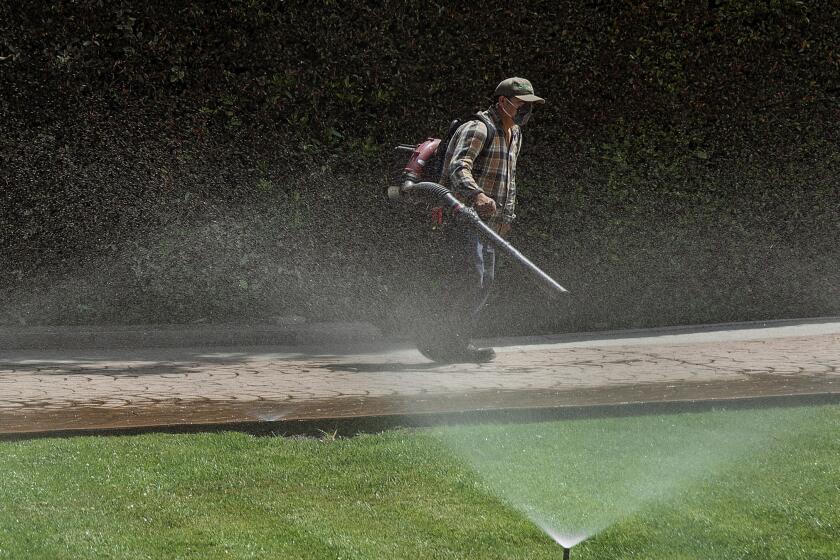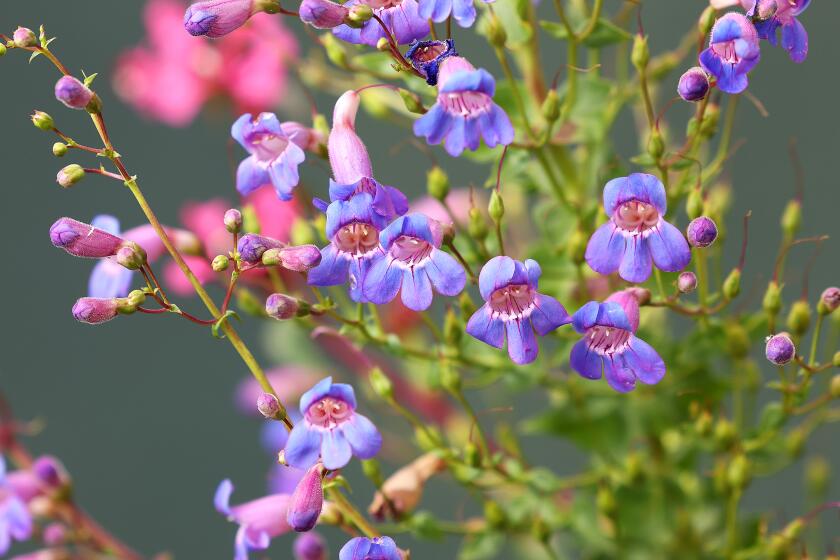Edible Plants
- Share via
There are better places than the waste bin to put those pesky dandelions that relentlessly sprout in the lawn and those abundant yellow-flowered mustard plants that have taken over the vacant lot next door.
Instead of cursing and discarding them, try eating them.
Going out for a quick bite to eat can take on a whole different meaning once you learn to recognize, gather and use native and other wild edible plants in your meals.
Rather than driving to a fast-food restaurant for that quick snack, you could be foraging in your own lawn for a nutrition-packed meal. Wild foods are often richer in vitamins and minerals than cultivated fruits and vegetables.
Precautions
* Be careful: Eating the wrong part of a plant, or even the right part at the wrong time of year, can make you sick. Also, it’s important to watch for allergies.
* Know your plants: Get a good book that includes either photographs of plants or well-done illustrations.
* Eat clean plants: Steer clear of heavily traveled roads where plants have absorbed a lot of auto emissions. Be sure the plants are being fed by a clean water source.
* Know the rules: Be aware of whose property you’re on and whether foraging is allowed. In the Santa Monica Mountains National Recreation Area. For example, gathering ripe fruit is permitted, but it must be eaten onsite.
Finding Out More
* Selected books: “Edible and Useful Plants of California” by Charlotte Clarke; “Wild Edible Plants of Western North America” by Donald R. Kirk, and “Guide to Wild Foods” by Christopher Nyerges.
* Classes: Pierce College and Glendale Community College offer field classes. Call Pierce Community Services at (818) 719-6425; for Glendale information, (818) 548-0864.
* Wild food outings: Wilderness Institute, (818) 991-7327; Earth Skills, (805) 245-0318; School of Self-Reliance, (213) 255-9502; W.O.L.F., (818) 991-2515; and W.I.L.D., (818) 781-4421.
Palatable Plants: A Local Menu
Yucca (Yucca whipplei)
* Where: Dry slopes from the desert to the mountains.
* When: Spring
* Taste: Shoot jicama-like, fruit like squash.
* Nutrition: Good protein source.
Dandelion (Taraxacum officinale)
* Where: Wild, just about anywhere.
* When: Spring and summer.
* Taste: Slight bitter taste. Leaves extremely bitter once plant flowers.
* Nutrition: Vitamins A, B and C, beta carotene, calcium, sodium and potassium.
Black Mustard (Brassica nigra)
* Where: Wild, covering hillsides and meadows.
* When: Winter and spring.
* Taste: Firm texture; horseradish-like taste mellows when cooked in soups and stews.
* Nutrition: Vitamins A, B and C, protein, calcium, phosphorous, iron and potassium.
Cattail (Typha latifolia)
* Where: Near bodies of water.
* When: Spring.
* Taste: All parts edible. Inner part of nonflowering shoots has cucumber-like taste.
* Nutrition: Shoots rich in potassium and phosphorous, good source of beta carotene.
Other Edible Greenery
Plant: Sow Thistle
What it tastes like: Slightly bitter
When to find it: Winter, spring, summer
Where it grows: Disturbed soil, gardens, stream banks
Which part to eat: Young, tender plants
How to use: Raw in salads, boiled, steamed or cooked in soups and souffles.
Nutrition: Vitamins A and C and calcium
*
Plant: Chickweed
What it tastes like: Mild and sweet
When to find it: Winter
Where it grows: Shady places, gardens, lawns
Which part to eat: All parts above soil
How to use: Salads, sandwiches, blended drinks.
Nutrition: Copper, C and B complex vitamins, potassium, calcium
*
Plant: Mallow / Cheese Weed
What it tastes like: Mild and sweet
When to find it: Winter, spring
Where it grows: Along roadsides, in gardens, disturbed soil
Which part to eat: Leaves, fresh seeds
How to use: Raw, boiled or steamed in soups, gumbos.
Nutrition: Vitamin A, potassium, calcium, beta carotene
*
Plant: Purslane
What it tastes like: Slightly tart, sweeter when cooked
When to find it: Summer
Where it grows: Lawns, gardens, cultivated fields
Which part to eat: Fleshy leaves, small stems
How to use: Salads, soups, gumbos.
Nutrition: Vitamin A, iron, potassium, riboflavin
*
Plant: Lamb’s-Quarters
What it tastes like: Green flavor, mellow when cooked
When to find it: Winter, spring, summer
Where it grows: Gardens, stream banks, vacant
Which part to eat: Leaves, dried seeds
How to use: Salads, soups, stews; dried seeds ground into meal
Nutrition: Rich in vitamins, minerals, particularly calcium
*
Plant: Curly Dock
What it tastes like: Sour lemon-like flavor
When to find it: Winter, spring, summer
Where it grows: Fields, dry open areas, lawns, stream banks
Which part to eat: Leaves, stems
How to use: Chopped or sauteed in salad and stuffing
Nutrition: High in vitamins and minerals
*
Plant: Amaranth
What it tastes like: Leaves taste like spinach
When to find it: Summer
Where it grows: Disturbed soil, cultivated fields, gardens
Which part to eat: Leaves, ground
How to use: Boiled seeds ground into meal for cereal, breads
Nutrition: Leaves: Calcium, potassium; seeds: phosphorous, calcium
*
Plant: Filaree
What it tastes like: Celery-like
When to find it: Winter, spring
Where it grows: Disturbed soil, roadsides, fields, lawns, cultivated areas
Which part to eat: Leaves, stems
How to use: Cooked like spinach, salads, soups, blended drinks.
Nutrition: Calcium, potassium
*
Plant: Miner’s Lettuce
What it tastes like: Leaves and stems are mildly flavored
When to find it: Winter, spring
Where it grows: Shaded, moist areas
Which part to eat: Leaves, stems
How to use: Salads or cooked like spinach.
Nutrition: Vitamin C
*
Plant: Toyon
What it tastes like: Chewy, apple-like bitter almond flavor
When to find it: Winter
Where it grows: Chaparral, southern oak woodlands
Which part to eat: Berry-like fruit
How to use: Eaten whole or chopped, should first be baked, boiled or dried, in pies, sauces and ciders.
Nutrition: High sugar content
*
Plant: Currant
What it tastes like: Soft, sweet, fleshy fruit
When to find it: Late spring, summer
Where it grows: Moist shaded or open land, riparian
Which part to eat: Berries
How to use: Eaten raw or baked for pies, preserves, sauces, wine.
Nutrition: Vitamin C, phosphorous, iron, sugar
*
Plant: Prickly Lettuce
What it tastes like: Slightly bitter like spinach
When to find it: Winter, spring
Where it grows: Disturbed soil, woodlands, meadows, stream banks, gardens
Which part to eat: Leaves
How to use: Salads, steamed or boiled.
Nutrition: Potassium
Sources: Naturalists Hilla Futterman, Christopher Nyerges and Robert Remedi; Q. Gatson, National Park Service ranger, and “Edible and Useful Plants of California” by Charlotte Clarke; Researched by SHARON MOESER / For The Times.






